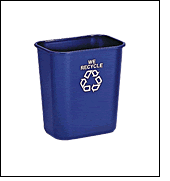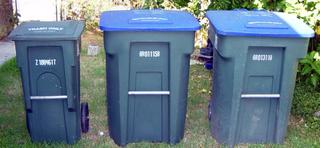1. Buy indoor recycle trash cans. Skip the grocery bag hanging on the back door.
If you have a mixed recycle bin from your trash hauler, then you can do the same inside your house. Most office supply stores carry a standard Rubbermaid(tm) office wastebasket in lovely clean-ocean blue, replete with the recycle logo and the proclamation "We Recycle." (Older versions used to list the types of paper that were acceptable, a somewhat quaint holdover from the early days.) Or you can order three different sizes online from Recy-CAL Supply among others. The medium size unit here lists for $6.00.

We have four of these around the house -- kitchen, office/dining room, kids rooms, etc. As recyclables come to the end of life they go into the blue trash; 10-year-old Spencer has as an "as needed" chore to dump the blue trash cans into the blue-lid Super Can from the City.
Many many people I have talked to about this use the bag-on-the-door or box-in-the-kitchen approach. Others use the bin outside the door approach. All these work great if you have very little recycling.
But the door-bag gets full, and the outside bin is a hassle. As a result, one tends to subconsciously recycle less, not more.
Remember, we use a 32 gallon, tiny can for our "trash," but fill one, sometimes two 60 gallon recycle bins. Week to week, our recycle to trash ratio is between 2:1 and 4:1.
Thus, Roger's Rule of Recycling: If you are not recycling twice the volume you put in the landfill, you aren't trying at all.
Room-based recycle bins make this very easy. If we had to carry 120 gallons of recycle out to the curb cans each day, we'd give up trying!
Our tiny trash, left, and our one or two recycle cans per week.

2. Recycle The Parts You Can.
A Barbie doll box is made of cardboard (recyclable) and un-numbered plastic (not recyclable). The plastic typically pulls off pretty easy, and the cardboard is now not in the landfill. A cereal box has a plastic bag of crumbs at the end of its life (neither crumbs nor bag recycle, although crumbs compost (grin)), and a pasteboard box. Trash the plastic, recycle the box.
Amusingly, this becomes pretty automatic and does not slow things down -- except when you start to notice which things come in reusable containers and which have vast amounts of ecologically morbid plastics or excess cardboard. We have been known to run around showing each other the trash when we come across a particularly novel feat of packaging engineering using reclaimable products.
3. Cheat.
This comes in two parts:
a. Never feel guilty if you throw away one can or a scrap of paper rather than get to the bin. The habit you will develop if you do not feel resentful and pressured over recycling will eventually more than make up for the occasional misguided soda can.
b. Not sure if that paper is ok to recycle? What about that can? In mixed recycling, toss it in anyway. There are still people down there inspecting your choices, who will reject anything you have overzealously included.
The in-house bins will have the biggest impact, of course. It never ceases to amaze me how many people have four or five or more trash cans around the house, and one recycle bag. And, of course, there are lots of ways to reduce your trash without increasing recycling output. But that's a screed for another day.
COMING SOON:
Red Tag Your Car (It's Easy!)

No comments:
Post a Comment